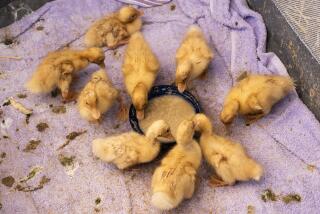Duck Drawing Wins Stamp of Approval
- Share via
WASHINGTON — Little by little, the ducks draw you in.
At first it’s hard to tell one entry from another, but after you’ve seen a couple of dozen acrylic, oil and watercolor paintings, an appreciation creeps up on you.
No. 34 won’t make the cut. That bird is tentative. A victim. Ready to surrender, the dim beads of his eyes crying out, “Baste me in orange sauce and be done with it already!”
Unlike No. 80 or No. 234. So tactile. So full of life. Renderings that invite you to reach out and stroke the delicate softness of their plumage. Or fantasize about centering them in the cross hairs.
The Federal Duck Stamp Contest winner was crowned Thursday at the Interior Department. After two days of ceremony and judging and hawking of all things migratory bird, a rendering by a young Ohio artist will grace the 2000-2001 stamp. The stamp, a kind of driver’s license for waterfowl hunters nationwide, is a major source of funds for federal conservation efforts.
And it’s a huge deal.
The event, which was begun in 1934, is the largest--and the only--federally sponsored art contest. The Super Bowl of waterfowl renderings, it can result in nearly a million bucks in speaking fees and heightened print sales, as well as overnight celebrity--albeit of a very narrow variety.
Like so many subcultures that dot the American landscape, this is one of particular, esoteric intensity. Competition is fierce, and the contest tightly regulated to prevent cries of foul. It even has a ruling family, a veritable duck stamp dynasty, which got a satirical sendup in the 1996 movie “Fargo.”
Before judging began Thursday, there were calls from mallard ducks and honks from Canada geese. But that was just Sean Mann, three-time world champion duck caller, warming up the crowd.
Then duck master Mark Hirchert ushered the Peabody Orlando Hotel marching ducks down the aisle. You can’t go to school to be a duck master, explains Hirchert earnestly; you just “need to be an animal lover, someone with a lot of patience. These ducks are very wild. They don’t know to stay on the carpet, they don’t know to stay in the duck fountain.”
After a love tour around the Interior building auditorium, the five ducks waded into a pool of lettuce, where they munched and kept a wary eye on their brother, the stuffed snow goose that sat just above them on an imitation marsh branch.
Ninety-eight percent of the proceeds from the $15 duck stamps are used to buy and support wetlands, which can seem ironic--a conservation model funded by hunters. But that’s the great misconception, says John Rogers, deputy director of the U.S. Fish and Wildlife Service.
“In order for there to be game to hunt, there has to be a healthy environment to support them,” Rogers says reasonably. “As long as we have a healthy resource, one of the most appropriate uses is hunting.”
People are lured to hunting by the outdoors, the camaraderie of family and friends, and the chance to pit their skills against nature’s finest, he says. “The fact that you are able to shoot something is a secondary outcome of the outdoor experience.”
Three-time duck stamp contest winner Jim Hautman of Plymouth, Minn., agrees. “I don’t think there’s any group of people that cares more about the ducks than the hunters,” says Hautman, the youngest in the legendary Hautman duck stamp dynasty. Brothers Joe and Bob have also won (1992 and 1996)--prompting Norm Gunderson, the artist in “Fargo” who enters the contest, to complain that “one of those Hautmans” would probably take it again.
Jim Hautman is a handsome, Chris O’Donnell, white-bread-soul kinda guy. He is asked for autographs as he wanders through this crowd, but he acknowledges that, depending on where he goes, he sometimes gets no play.
“New York, for instance,” Hautman says, thoughtfully. They are less well versed in the migratory bird arts there.
The competition also lures non-hunters, like artist John R. Sander, a State Department official who carves decoys. He disagrees that hunters care most about the bird.
“Obviously they are not stupid,” he says. “They know that if you ruin all the wetlands, you’re not going to have anything to shoot at anymore.”
Duality. The duck stamp contest has it.
This year’s competition, open to anyone 18 and older for a $100 entry fee, got 243 entries. Since it is a government-sponsored program, there are layers of rules, regulations and lawyerly oversight. There is heavy emphasis on biological correctness. Most important, the paintings must feature live birds.
By Thursday, the field had been narrowed to 17, and nearly 100 people dotted the auditorium--contestants’ relatives, last year’s junior second runner-up, a woman from a bird-banding lab . . . it is impossible to find a non-bird affiliate in the crowd.
As the judges viewed the final ducks, the crowd held itself in an expectant hush. A tiebreaker was held for first place. Entry No. 11 was projected onto the big screen, but there was a particular energy around No. 234. As the final score was posted, the audience erupted into applause.
The winner: a mottled duck by Adam Grimm, 21, an art student from Elyria, Ohio, who was in class and had to be reached by phone with the news. He is the youngest-ever duck stamp winner (grabbing that title from Jim Hautman), a 1996 junior runner-up, an avid photographer. And a hunter.
More to Read
The biggest entertainment stories
Get our big stories about Hollywood, film, television, music, arts, culture and more right in your inbox as soon as they publish.
You may occasionally receive promotional content from the Los Angeles Times.










